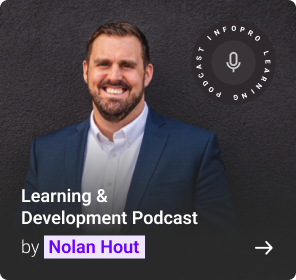The Problem Facing L&D
Companies have extensive investments in Training Programs and that content is depreciating at a staggering rate.
Training programs become unusable, irrelevant, or outdated if they are not properly managed and maintained. Companies that constantly maintain and reuse their learning assets enjoy a much better return on investment for training expenditure.1 The value of outdated workplace training programs can be maximized by reducing the amount of extraneous content, reusing instructionally sound content, and recycling content with an eye towards improving and modernizing its design.
Reducing the amount of extraneous training content improves the impact of training and increases learner engagement.
A common issue with older training programs is that they are overly long, contain too much information for employees to remember on the job,2 and rehash some of the same concepts multiple times throughout the program. After auditing older training programs, learning professionals can strategically prune away extraneous training content to ensure that whatever content remains is more succinct and impactful.5 As long as the content is instructionally sound and contains useful information, it can be leveraged for the development of new training programs in the future as well.
Perform an Audit
Auditing your training portfolio and identifying extraneous content that can be condensed or removed requires a critical eye. Here are four questions to keep in mind when performing a training portfolio audit:
- Are the programs too time consuming?Training workshops that pull employees away from their jobs days at a time and hour long e-learning courses are good candidates for consolidation. Think 70/20/10
- Will learners suffer from information overload?Learners can only retain so much information at a time from formal training programs. Content that is too information-rich and relies on workers to memorize lots of information becomes unwieldy and should be condensed.
- Are there learning assets that have gotten negative feedback from workers?Unpopular training content should be removed from your company’s training portfolio. However, if some of the base content is still useful, it should be partitioned away from the program as a whole instead of deleting it.
- Are there learning objects that are no longer accessible due to technological limitations?For e-learning content in particular, older content published in legacy formats can become inaccessible on modern Internet browsers, learning management systems, and mobile devices.
After Reducing Now What?
Reducing extraneous content is only the first step to maximize training ROI. Read more, download the Modernize eBook from InfoPro Learning.
- Ebbinghaus, H. (1885). “Memory: A Contribution to Experimental Psychology.” Translated by Ruger, H., & Bussenius, C. (1913). New York: Teachers College, Columbia University.
- Barker, E., James, H., Knight, G., et. al. (2004). “Long-Term Retention and Reuse of E- Learning Objects and Materials.” Report commissioned by the Joint Information Systems Committee (JISC).
Access our verified pool of over 7,000+ L&D Professionals currently available for short and long-term engagements in more than 40+ countries. Whether you need Trainers, LMS Admins, Instructional Designers, or anything in between, we can be your sole source for building out a world-class team.
Contact us to know more about Talent as a Service.




